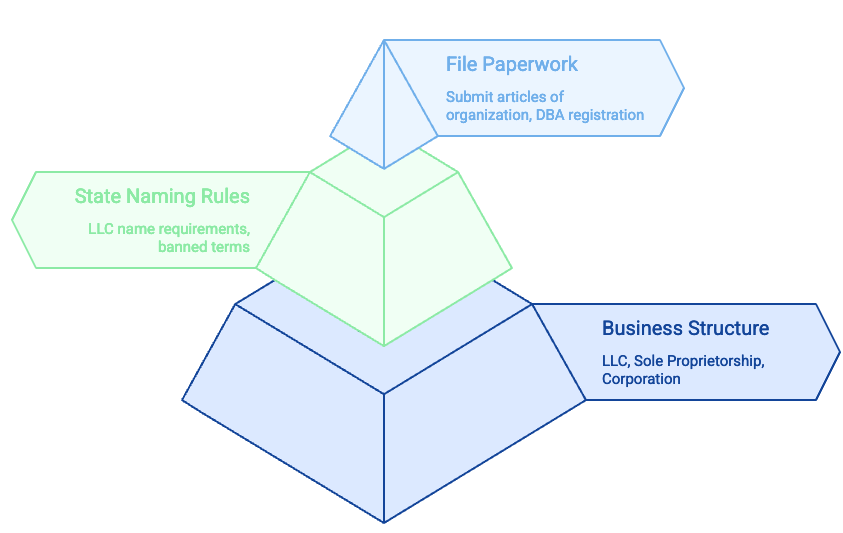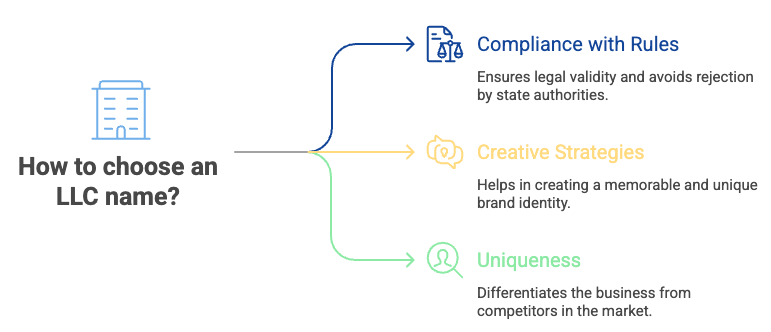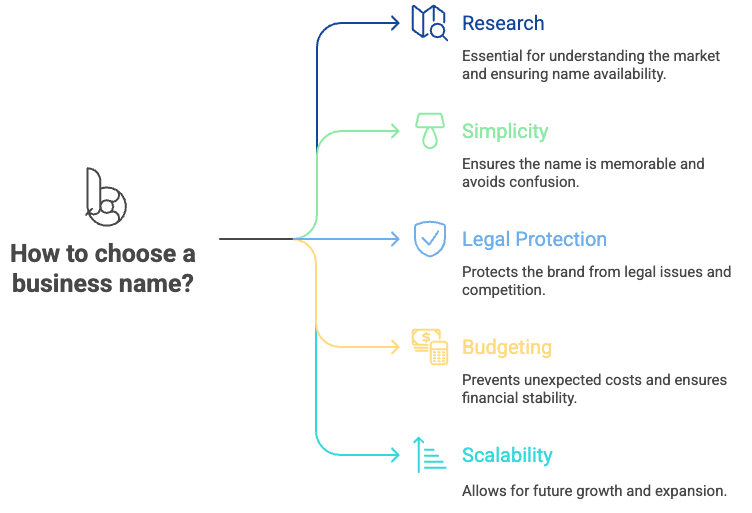Let’s start with a question: What do “Google,” “Zoom,” and “Uber” have in common? They’re all short, punchy, and instantly recognizable—proof that a great business name can shape your brand’s destiny. Your business name isn’t just a placeholder; it’s the foundation of your identity, the first impression you make, and something that stays with your brand forever.
Imagine naming your business like getting a tattoo—it’s permanent, visible, and says a lot about who you are. A poorly chosen name could lead to confusion, legal battles, or even costly rebranding down the line (Forbes estimates that rebranding can cost from $40,000 to six figures). On the other hand, a strong name does something essential—it helps customers remember your brand.
Recent trends show a shift toward simplicity. Businesses are ditching quirky spellings (for example - “Krazy Kuts Salon”) for clean, easy-to-remember names. In India, for example, startups are racing to claim names starting with “Z” (think “Zomato” or “Zepto”), a trend linked to perceptions of modernity and innovation. But trends come and go—what matters is choosing a name that grows with you.
Ready to dive deeper? Let’s talk strategy.
How to Name a Business: A Step-by-Step Guide
So, you’ve got a brilliant business idea. Now, how do you translate that energy into a name that sticks? Let’s break it down into actionable steps—no jargon, just practical advice.
Start with Brainstorming (Lots of It!)
Grab a notebook or open a Google Doc and let the ideas flow. Think about:
-
Your mission: What problem does your business solve? (e.g., “Evernote” hints at remembering everything)
-
Your audience: Will they respond better to playful, professional, or quirky?
-
Keywords: Use tools like Google Keyword Planner to find terms your customers search for.
Don’t filter yourself yet—quirky ideas often lead to gold. For example, “Twitter” started as a placeholder name inspired by bird chirps, and look how that turned out!
Check Availability (Before You Get Attached)
Falling in love with a name that’s already taken is like swiping right on someone who’s off the market. Avoid heartbreak by:
-
Searching for trademarks: Use the USPTO’s Trademark Database (or your country’s equivalent).
-
Securing a domain: A “.com” is still king.
-
Grabbing social handles: Use Namecheckr to see if your name is free across platforms.
Test It Out Loud
Say the name in a sentence: “Let me check with [Your Business Name].” Does it flow naturally?
Avoid tongue twisters like “Swiwy” (Is it “Swee-vee” or “Swai-ee”?).
Compare Naming Strategies: DIY vs. Professional Help
Not sure whether to brainstorm solo or hire experts? Here’s a quick comparison:
|
Approach |
Pros |
Cons |
Cost |
|
DIY Naming |
Full creative control |
Time-consuming; risk of legal oversights |
$0 (but time-heavy) |
|
Naming Agency |
Expertise in branding & trademark laws |
Higher upfront cost |
$5,000–$50,000+ |
|
Crowdsourcing |
Fresh ideas from diverse perspectives |
May lack cohesion |
$100–$1,000 |
(Source: Naming Agency Cost Breakdown)
If you’re bootstrapping, DIY works, but professionals can dodge pitfalls you might miss. For instance, naming agencies often use linguistic checks to ensure your name doesn’t mean something offensive in another language
Future-Proof Your Name
Ask yourself:
-
Does it scale? “Boston Bakery” might limit you if you expand to Miami.
-
Is it timeless? Avoid trends like “Blockchain Buddies” unless you’re potentially ready to rebrand in 5 years.
💡Pro tip: If you’re forming an LLC, check your state’s naming rules. Most require “LLC” in the name, but some ban certain words like “Bank” without approval.
How to Trademark a Business Name (and Why You Absolutely Should)
Picture this: You’ve nailed the perfect name, launched your business, and built a loyal customer base. Then, out of nowhere, a cease-and-desist letter arrives because another company claims they had the name first. That could cost you millions. Trademarking isn’t just legal red tape—it’s your shield against copycats and confusion.
What Does a Trademark Actually Do?
A trademark gives you exclusive rights to use your business name, logo, or slogan in your industry. Without one, anyone could steal your brand identity, and you’d have little recourse. Take the infamous Apple vs. Apple Corps battle—a decades-long feud over the name “Apple” between a tech giant and a music label.
The Trademark Process: Simplified
-
Search for Conflicts:
Use the USPTO’s Trademark Electronic Search System to ensure your name isn’t already claimed. Don’t skip this—over 40% of applications are rejected due to conflicts. -
File Your Application:
Submit online via the USPTO website. You’ll need: -
A clear description of your goods/services
-
Proof of use (if already operating) or “intent to use”
-
The filing fee per class of goods ranges from $250- $350 (much less than millions lost on legal disputes)
-
Wait (and Wait Some More):
Approval takes 6–12 months. Track your status in the USPTO portal.
DIY vs. Hiring a Trademark Attorney: Which Saves More Headaches?
There are advantages and disadvantages of applying for a trademark yourself. If your business operates in multiple states or industries, a lawyer is worth the investment. For solo entrepreneurs, DIY works if you’re meticulous.
|
Approach |
Pros |
Cons |
Cost |
|
DIY Trademark |
Save on legal fees |
Risk of errors; higher rejection odds |
$250–$350 + time |
|
Trademark Attorney |
Expertise in complex cases; faster process |
Higher upfront cost |
$500–$2,000+ |
(Source: USPTO Trademark Basics)
Pro Tip: Even after approval, monitor for infringements. Tools like Trademark Watch alert you to copycats.
Business Naming Launch Checklist
Take the guesswork out of launching your business name with our interactive checklist. It guides you through every step—from securing your domain and trademarks to ensuring social media handles are available. It ensures your name is legally, culturally, and SEO-friendly.
How to Register a Business Name: Don’t Skip This Step
Trademarking protects your brand, but registering your business name makes it official with the government. Here’s the lowdown:
What’s the Difference Between Trademarking and Registering?
-
Trademark: Protects your brand nationally.
-
Registration: Legally establishes your business structure (LLC, corporation, etc.) in your state.
Steps to Register Your Business Name
-
Choose Your Business Structure:
-
LLC: Flexible, protects personal assets.
-
Sole Proprietorship: Simplest, but no liability protection.
-
Corporation: Ideal for scaling or seeking investors.
-
Check State Naming Rules:
Most states require LLCs to include “LLC” or “Limited Liability Company” in the name. Banned terms vary—for example, as already mentioned,“Bank” often requires extra approvals. There’s a list of words that can’t be part of a brand name (some examples are - statue, minister, nation…) -
File Your Paperwork:
-
LLC/Corporation: Submit articles of organization to your state’s Secretary of State.
-
Sole Proprietorship: Register a “Doing Business As” (DBA) name if you’re not using your legal name.

Cost Alert: Registration fees range from $50 (Texas) to $500 (Massachusetts). Check your state’s business portal for specifics.
Why a DBA Matters
A DBA (“Doing Business As”) lets you operate under a name that isn’t your legal one. Example: If Jane Doe runs a bakery, her DBA could be “Sweet Treats by Jane.” It’s affordable (usually $10–$100) and easy to file.
Pro Tip: Even after registering, recheck the domain and social handles. Consistency is key!
Ready for the next section? We’ll tackle creative strategies for small businesses and LLCs—including how to dodge overused names and find one that grows with you.
How to Pick an LLC Name (Without Losing Your Mind)
Naming an LLC isn’t just about creativity—it’s about compliance. Unlike a catchy DBA, your LLC name needs to meet state rules and stand out in a crowded market. Let’s break it down:

LLC Naming Rules You Can’t Ignore
-
Include “LLC” or “Limited Liability Company”: Most states require this (e.g., “Brew Haven LLC”).
-
Avoid Restricted Words: Terms like “Bank,” “University,” or “FBI” often need special approvals.
-
Stay Unique: Your name must differ from existing businesses in your state. Check your Secretary of State’s business database before filing.
Creative Strategies for LLC Names
-
Blend Words: Combine industry terms with a twist (e.g., “Netflix” = Internet + Flicks).
-
Use Metaphors: “Summit Marketing” implies growth and achievement.
-
Add Location Sparingly: “Austin Electric Co.” works if you’re staying local, but ditch it if you plan to expand.
Bad LLC Name: “Best Marketing Services LLC” (Too generic)
Good LLC Name: “ContentCraft Labs LLC” (Specific, memorable, and compliant)
What Is a Good Name for a Small Business? Spoiler: It’s Not What You Think
Small businesses thrive on personality, but your name also needs to work harder. Here’s the scoop:
Traits of Winning Small Business Names
-
Short & Sweet: Aim for 1–3 syllables (e.g., “Sprint” or “Slack”).
-
Easy to Spell: If people need to Google “how to spell [your name],” it’s a problem.
-
Flexible: “Tina’s Cupcakes” is cute but limiting if you add cookies later.

Case Study: “Amazon” started as an online bookstore but chose a name evoking vastness (the Amazon River) to scale into… well, everything.
Personal Name vs. Creative Name: Which Wins?
|
Factor |
Using Your Name (e.g., “Smith & Sons”) |
Creative Name (e.g., “EcoBloom”) |
|
Memorability |
Low (unless you’re already famous) |
High |
|
Scalability |
Limited by personal brand |
Unlimited |
|
Trademark Ease |
Harder (common names clash) |
Easier |
|
Sale Potential |
Lower (buyers want neutral brands) |
Higher |
(Source: The Trademark Search Company)
💡Pro Tip: Test your name with strangers. If they can’t spell or remember it after one hearing, go back to the drawing board.
How Much Does It Cost to Name a Business? Let’s Crunch Numbers
Naming your business can cost anywhere from $20 to $50,000+. Here’s where the money goes:
Breakdown of Naming Costs
|
Expense |
DIY Approach |
Professional Help |
|
Domain Name |
$10–$20/year |
$500–$5,000 (premium domains) |
|
Trademark Filing |
$250–$350 |
$500–$2,000 (with attorney) |
|
Business Registration |
$50–$500 (state fees) |
Included in LLC packages |
|
Naming Agency |
$0 |
$5,000–$50,000+ |
|
Rebranding (Oops!) |
$10,000–$200,000+ |
Avoidable with research |
The Hidden Cost of Cheap Names: A poorly chosen name can lead to lost sales. When Mercedes-Benz entered the Chinese market, they picked the name “Bensi,” which means “rush to die.”
Wrapping up with pro insights on avoiding naming regrets and leveraging your name for long-term success. Ready for the finish line?
Key Takeaways and Final Thoughts
Let’s wrap this up with a bow. Your business name isn’t just a label—it’s the cornerstone of your brand’s legacy. Whether you’re a solopreneur or launching the next unicorn startup, here’s what to remember:
Key Takeaways
-
Do the Homework: Research competitors, check domain/trademark availability, and test names with real humans.
-
Keep It Simple: Avoid tongue-twisters and trendy jargon. Think long-term, not viral moment.
-
Legal First, Vibes Later: Trademarking and registration aren’t optional if you want to protect your brand.
-
Budget Wisely: Naming costs can spiral—plan for domains, trademarks, and maybe professional help.
-
Stay Scalable: A name that works today should still work when you’re selling globally or expanding your product line.

The Cost of Getting It Wrong
Rebranding isn’t just expensive—it’s messy. Take RadioShack, which spent $200 million rebranding to “The Shack” only to confuse customers and lose market share. In 2017, Kylie Minogue, a music star won a legal battle against Kylie Jenner over the trademark for the name “Kylie,” preventing Jenner from securing exclusive rights.
When to Call in the Pros
If you’re stuck between names or entering a saturated market (looking at you, CBD and AI startups), naming agencies like Igor International or Namelix can save time and stress. Yes, they’re pricey, but their expertise in linguistics, trademarks, and global branding often pays for itself.
However, if you’re on a tight budget—especially as a startup—AI search tools can be a great alternative. Simply enter your keywords, and these tools will generate name suggestions along with domain availability. This way, you can kill two birds with one stone. They also suggest relevant TLDs that fit your brand’s niche, making it easier to establish a strong online presence without breaking the bank.
Final Word
Think of your business name as your first employee—it’s there to make a great impression, work hard, and grow with you. Don’t rush it. Sleep on it. Say it out loud. And if you’re torn between two names, ask yourself: Which one will still feel right in 10 years?
Ready to make it official? Start with a trademark search, secure that domain, and go build something amazing.
FAQs
How do I choose a memorable business name?
Here are some tips on how can you choose a memorable business name:
-
Short & simple: Opt for names that are easy to spell and pronounce.
-
Reflect your brand: Align the name with your industry or values (e.g., Kindness Animal Hospital).
-
Check availability: Verify domain names, social handles, and legal registrations to avoid conflicts.
What makes a business name “catchy”?
Here are examples of catchy names:
-
Use alliteration (e.g., PrimaCARE) or rhymes (e.g., Hobby Lobby).
-
Incorporate wordplay (e.g., ExeCuteIve for an executive coaching LLC).
-
Evoke emotion or imagery (e.g., Phoenix LLC for resilience).
How do I name an LLC effectively?
Here are some tips to name a LLC effectively:
-
Include required terms like “LLC” or “Limited Liability Company”- most states require this to be included in the brand name.
-
Ensure uniqueness to avoid confusion with existing businesses (e.g., Mentor LLC).
-
Balance creativity with clarity (e.g., Squeaky Clean for a cleaning service).
How can I check if a business name is available?
Here is a quick way you can check if your business name is available:
-
Use state-specific databases like California’s Business Search.
-
Conduct a trademark search via the USPTO’s TESS system.
-
Secure matching domain names (e.g., YourBusinessName.com).
Should I use my personal name for my business?
Here are some pros and cons of using your name in your business’ brand name:
-
Pros: Builds trust (e.g., The Career Coach) and simplifies branding.
-
Cons: Limits scalability if expanding beyond personal expertise.
-
Hybrid option: Combine your name with a descriptor (e.g., Jane Doe Consulting).
